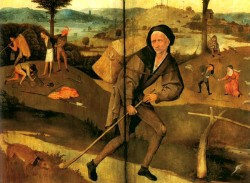
Péman 1961
“Sobre la interpretación del viandante al reverso del Carro de Heno de El Bosco” (César Péman) 1961
[in: Archivo Español de Arte, vol. XXXIV (1961), pp. 125-139]
[Also mentioned in Gibson 1983: 122 (E285)]
This article focuses on an interpretation of the closed wings of Bosch’s Haywain triptych (CWH), but the Rotterdam Pedlar tondo (RP) also gets a lot of attention. Pémans point of departure is the marginal illustration from the Luttrell Psalter that was introduced to Bosch scholarship by Seligmann (see Seligmann 1953). Seligmann pointed out that in this illustration the pedlar, who is bitten by a dog, is walking to the left towards a siren who symbolically refers to Unchastity, and that the pedlar in RP is walking to the right, in the good direction, away from sin. Péman agrees with this interpretation and also applies it to CWH, where the pedlar is also walking to the right. Furthermore he signals – again in agreement with Seligmann – that in RP the dog is growling in an aggressive way but he doesn’t bite the protagonist of the painting, although the bandaged lower leg of the pedlar seems to imply that he has been bitten in the past. This is why Péman considers the pedlar in RP to be a repentant sinner. That the movement towards the right has to be interpreted in a positive way as following the road to salvation (el camino de salvación) is confirmed by the fact that three other (clearly positive) persons in the work of Bosch are moving in the same way: Saint James the Elder on the closed wings of the Vienna Last Judgement triptych, Saint Christopher on the Rotterdam panel and the layman who is helping to carry Saint Anthony on the left inner wing of the St. Anthony triptych in Lisbon.
Péman interprets the vagabond in RP as a ‘homo viator’ in the Augustinian sense (man on his journey through life) and as a repentant sinner who after his reform follows the straight, narrow path leading to eternal bliss, as opposed to the people who are going astray (extraviados) in and around the brothel. To illustrate this theme Bosch used the parable of the Prodigal Son, which is not the main subject of the tondo but only functions as a convenient means of transport to convey the actual message. Since the protagonist of RP is walking in the same direction as the protagonist of CWH, it seems obvious to interpret both vagabonds in a similar way. The protagonist of CWH is also a ‘homo viator’ and a repentant sinner, but this time Bosch does not refer to the Prodigal Son, but to sinful and repentant mankind in general.
The repentant sinner in CWH is moving across the good, narrow path to the right, in the direction of the ‘bridge of salvation’ (al puente de salvación), keeps the aggressive dog (the devil) at a distance with a stick (just like the protagonist of RP) and stays away from those who have gone astray (symbolized by the robbers at the left and the dancers at the right). According to Péman CWH functioned as the devotional epilogue of the story that is being told on the inner panels of the Haywain triptych: after the spectator has observed the origin, propagation and punishment of sin, the closed wings invite him to meditate on the folly of sin and to choose the narrow path of salvation, turning away from sin.
Péman’s article offers some interesting ideas, a number of which had already been signalled in the former literature about CWH and RP: the observation that CWH and RP should be interpreted in a similar way and the link between Bosch’s pedlars and the pedlar in the Luttrell Psalter. In 1946 Combe had already briefly touched upon the opposition pedlar-dog but Pémans agreement with Seligmann’s observation (based upon the marginal illustration in the Luttrell Psalter) that Bosch’s pedlars are not being bitten by a dog but – definitely so in the case of RP – have once been bitten, again confirms the revealing character of this conclusion. A revealing precedent is Péman’s linking of the inner and outer panels of the Haywain triptych. It is a pity, though, that Péman does not elaborate on this simple observation and does not give further arguments to show that the dogs in RP and CWH indeed represent the devil. Also his positive interpretation of the movement towards the right of the protagonists in RP and especially in CWH is problematical: the sinful people on the Haywain’s central panel are also moving towards the right, in the direction of Hell! A weaker aspect of Péman’s argument is also that he does not pay enough attention to the fact that the protagonists of RP and CWH are pedlars, whereas the starting point of his article is an illustration of a pedlar. But the weakest link in his chain of arguments is that the parable of the Prodigal Son plays a role in his interpretation of RP, but not in his interpretation of CWH. Because of this his assertion that in CWH we are not dealing with the Prodigal Son, but with the repentant sinner in general, sounds rather artificial.
[explicit 2000]